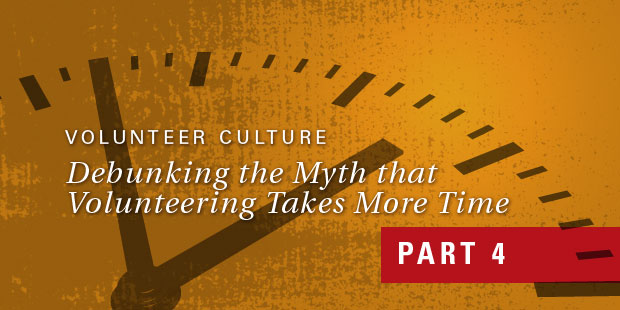
Volunteer Culture: Debunking the Myth that Volunteering Takes More Time – Part 4
For the next several posts about creating and cultivating a volunteer culture, I’ll pull from my second book, Lasting Impressions: From Visiting to Belonging, to review some common myths that prevent people from stepping up to serve in the local church (or any organization).
MYTH #1: “There’s no room for me; it’s all being done already.”
- You and I know nothing could be further from the truth. Unless it’s really true, of course. Maybe your staff is doing it all. Maybe you’ve structured things in such a way that there really are not new opportunities for new peeps. True or not, people tend to believe the myth.
- For instance, at Granger our guests and returning guests pull into the parking lot where they are directed by a traffic team to an open parking space. At the front door of the building they are greeted by one or more volunteers who welcome them to the service. A team is ready at the children’s check-in area, with campus guides available if the family needs assistance getting to children’s launch zones or rooms. There are friendly teams of people throughout the children’s center and each classroom with a prepared room for the session’s activities. When they visit the restroom they discover that someone has cleaned the space, stocked tissue and deodorized.
In the auditorium they discover that someone has prepared a printed program, while someone else has prepared the space with seating, lighting and ambient music. During the service it’s clear that there were teams of artists who practiced and presented music, media and drama. The pastor was prepared with a message relevant to their world. Everything was thought of; everything was covered. “They must have all the volunteers and staff they need,” thinks the normal Granger attendee.
My guess is this is a common myth in your church as well. Every staff and volunteer leader knows it’s a myth. There’s always room for more volunteers.
- Debunk MYTH #1
- Talk about it. Don’t assume people will figure this out on their own. They won’t. Say the myth aloud from the platform. At Granger it’s a myth we frequently speak to, directly and simply: “There are abundant opportunities to make a contribution. There’s room for you.” And then we’ll point to the variety of areas where our people can jump in and make a contribution. It seems too simple: talk about it. But the simple is easy to overlook. So, I’ll say it again, talk about it.
- “Chunk” new roles: In their book Simply Strategic Volunteers, Tony Morgan and Tim Stevens use this phrase to talk about breaking any volunteer project or role down to its many parts. If you have one volunteer responsible for getting the toddler space ready for the weekend, chunk the responsibilities to include more people: toy washers, floor cleaners, people who copy, cut or collate activity sheets. One person doesn’t have to do it all. As roles are chunked you create more opportunities for volunteers.
- Make sure it’s a myth. If I hear a ministry area in our church boast of having enough volunteers, there’s generally a “come to Jesus meeting” called. If you have teams who can’t find ways to involve more people it needs to be addressed. In more cases than not, that team has stopped dreaming, become cozily settled in their “we four and no more” team of friends or hit a lull in their creative approach to include more volunteers. Only in our band where there are limited instruments do we occasionally find ourselves in a season of “enough.” Tony Morgan puts it this way: “The church can’t afford to have “Not Hiring” signs posted at the door.”
Adapted from Lasting Impressions, Group Publishing

Tags: Mark Waltz, Serve, Volunteer Culture












